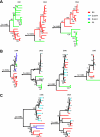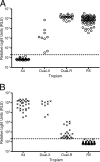Coreceptor tropism in human immunodeficiency virus type 1 subtype D: high prevalence of CXCR4 tropism and heterogeneous composition of viral populations
- PMID: 17507467
- PMCID: PMC1951291
- DOI: 10.1128/JVI.00218-07
Coreceptor tropism in human immunodeficiency virus type 1 subtype D: high prevalence of CXCR4 tropism and heterogeneous composition of viral populations
Abstract
In human immunodeficiency virus type 1 (HIV-1) subtype B, CXCR4 coreceptor use ranges from approximately 20% in early infection to approximately 50% in advanced disease. Coreceptor use by non-subtype B HIV is less well characterized. We studied coreceptor tropism of subtype A and D HIV-1 collected from 68 pregnant, antiretroviral drug-naive Ugandan women (HIVNET 012 trial). None of 33 subtype A or 10 A/D-recombinant viruses used the CXCR4 coreceptor. In contrast, nine (36%) of 25 subtype D viruses used both CXCR4 and CCR5 coreceptors. Clonal analyses of the nine subtype D samples with dual or mixed tropism revealed heterogeneous viral populations comprised of X4-, R5-, and dual-tropic HIV-1 variants. In five of the six samples with dual-tropic strains, V3 loop sequences of dual-tropic clones were identical to those of cocirculating R5-tropic clones, indicating the presence of CXCR4 tropism determinants outside of the V3 loop. These dual-tropic variants with R5-tropic-like V3 loops, which we designated "dual-R," use CCR5 much more efficiently than CXCR4, in contrast to dual-tropic clones with X4-tropic-like V3 loops ("dual-X"). These observations have implications for pathogenesis and treatment of subtype D-infected individuals, for the association between V3 sequence and coreceptor tropism phenotype, and for understanding potential mechanisms of evolution from exclusive CCR5 use to efficient CXCR4 use by subtype D HIV-1.
Figures






Similar articles
-
Chemokine (C-C motif) receptor 5-using envelopes predominate in dual/mixed-tropic HIV from the plasma of drug-naive individuals.AIDS. 2008 Jul 31;22(12):1425-31. doi: 10.1097/QAD.0b013e32830184ba. AIDS. 2008. PMID: 18614865
-
Differences in molecular evolution between switch (R5 to R5X4/X4-tropic) and non-switch (R5-tropic only) HIV-1 populations during infection.Infect Genet Evol. 2010 Apr;10(3):356-64. doi: 10.1016/j.meegid.2009.05.003. Epub 2009 May 14. Infect Genet Evol. 2010. PMID: 19446658
-
Higher prevalence of predicted X4-tropic strains in perinatally infected older children with HIV-1 subtype C in India.J Acquir Immune Defic Syndr. 2012 Apr 1;59(4):347-53. doi: 10.1097/QAI.0b013e3182405c7b. J Acquir Immune Defic Syndr. 2012. PMID: 22107818
-
Effect of HIV-1 subtype and tropism on treatment with chemokine coreceptor entry inhibitors; overview of viral entry inhibition.Crit Rev Microbiol. 2015;41(4):473-87. doi: 10.3109/1040841X.2013.867829. Epub 2014 Mar 17. Crit Rev Microbiol. 2015. PMID: 24635642 Review.
-
HIV-1 subtype C predicted co-receptor tropism in Africa: an individual sequence level meta-analysis.AIDS Res Ther. 2020 Feb 7;17(1):5. doi: 10.1186/s12981-020-0263-x. AIDS Res Ther. 2020. PMID: 32033571 Free PMC article. Review.
Cited by
-
Variation in the biological properties of HIV-1 R5 envelopes: implications of envelope structure, transmission and pathogenesis.Future Virol. 2010 Jul;5(4):435-451. doi: 10.2217/fvl.10.34. Future Virol. 2010. PMID: 20930940 Free PMC article.
-
Genotypic prediction of HIV-1 subtype D tropism.Retrovirology. 2011 Jul 13;8:56. doi: 10.1186/1742-4690-8-56. Retrovirology. 2011. PMID: 21752271 Free PMC article.
-
Vertical transmission of X4-tropic and dual-tropic HIV-1 in five Ugandan mother-infant pairs.AIDS. 2009 Sep 10;23(14):1903-8. doi: 10.1097/QAD.0b013e32832f1802. AIDS. 2009. PMID: 19593079 Free PMC article.
-
Risk of breast cancer with CXCR4-using HIV defined by V3 loop sequencing.J Acquir Immune Defic Syndr. 2015 Jan 1;68(1):30-5. doi: 10.1097/QAI.0000000000000400. J Acquir Immune Defic Syndr. 2015. PMID: 25321183 Free PMC article.
-
CD41 T cell recovery during suppression of HIV replication: an international comparison of the immunological efficacy of antiretroviral therapy in North America, Asia and Africa.Int J Epidemiol. 2015 Feb;44(1):251-63. doi: 10.1093/ije/dyu271. Int J Epidemiol. 2015. PMID: 25859596 Free PMC article.
References
-
- Abebe, A., D. Demissie, J. Goudsmit, M. Brouwer, C. L. Kuiken, G. Pollakis, H. Schuitemaker, A. L. Fontanet, and T. F. Rinke de Wit. 1999. HIV-1 subtype C syncytium- and non-syncytium-inducing phenotypes and coreceptor usage among Ethiopian patients with AIDS. AIDS 13:1305-1311. - PubMed
-
- Alkhatib, G., C. Combadiere, C. C. Broder, Y. Feng, P. E. Kennedy, P. M. Murphy, and E. A. Berger. 1996. CC CKR5: a RANTES, MIP-1α, MIP-1β receptor as a fusion cofactor for macrophage-tropic HIV-1. Science 272:1955-1958. - PubMed
-
- Asjo, B., L. Morfeldt-Manson, J. Albert, G. Biberfeld, A. Karlsson, K. Lidman, and E. M. Fenyo. 1986. Replicative capacity of human immunodeficiency virus from patients with varying severity of HIV infection. Lancet ii:660-662. - PubMed
-
- Baeten, J. M., B. Chohan, L. Lavreys, V. Chohan, R. S. McClelland, L. Certain, K. Mandaliya, W. Jaoko, and J. Overbaugh. 2007. HIV-1 Subtype D infection is associated with faster disease progression than subtype A in spite of similar plasma HIV-1 loads. J. Infect. Dis. 195:1177-1180. - PubMed
-
- Bjorndal, A., A. Sonnerborg, C. Tscherning, J. Albert, and E. M. Fenyo. 1999. Phenotypic characteristics of human immunodeficiency virus type 1 subtype C isolates of Ethiopian AIDS patients. AIDS Res. Hum. Retrovir. 15:647-653. - PubMed
Publication types
MeSH terms
Substances
Grants and funding
- R44 AI048990/AI/NIAID NIH HHS/United States
- U01 AI068613-02/AI/NIAID NIH HHS/United States
- N01 AI045200/AI/NIAID NIH HHS/United States
- U01- AI-46745/AI/NIAID NIH HHS/United States
- N01 AI035173/AI/NIAID NIH HHS/United States
- N01-AI-35173-417/AI/NIAID NIH HHS/United States
- U01 AI048054/AI/NIAID NIH HHS/United States
- R44-AI-048990/AI/NIAID NIH HHS/United States
- U01 AI068613/AI/NIAID NIH HHS/United States
- U01-AI-068613/AI/NIAID NIH HHS/United States
- R01-HD-042965-01/HD/NICHD NIH HHS/United States
- U01-AI-48054/AI/NIAID NIH HHS/United States
- R01 HD042965/HD/NICHD NIH HHS/United States
- U01 AI046745/AI/NIAID NIH HHS/United States
LinkOut - more resources
Full Text Sources
Molecular Biology Databases

